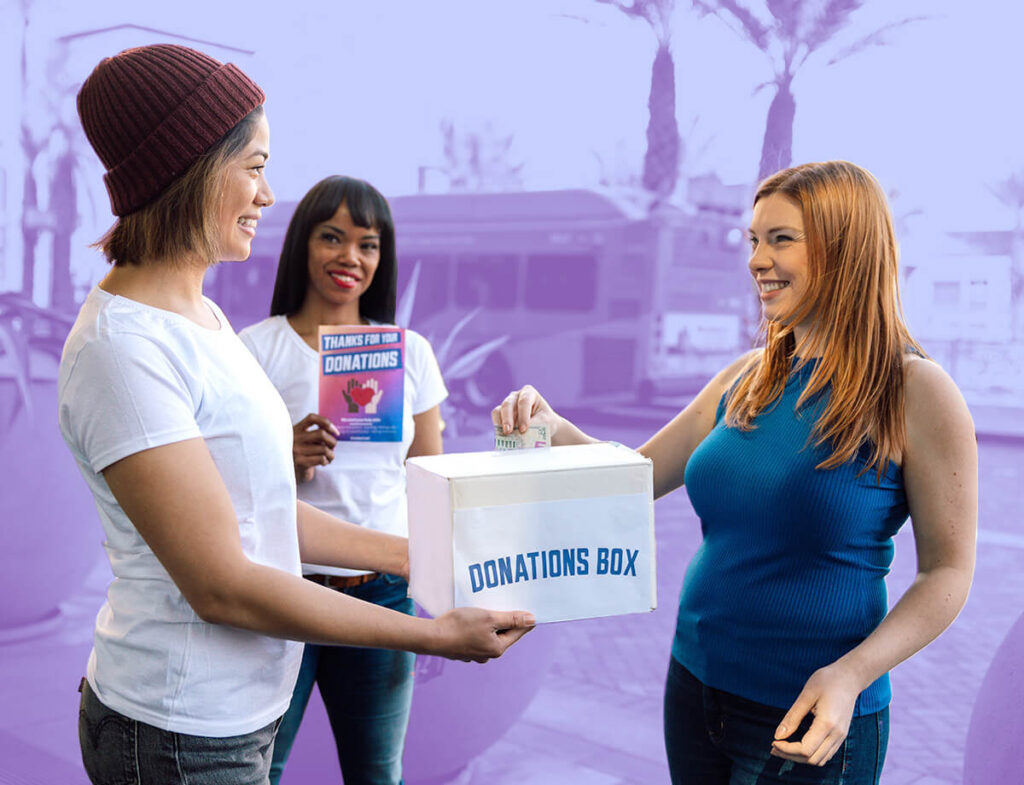30+ facts about volunteering and statistics to inspire and engage employees

What are some interesting facts about volunteering?
Almost 30% of Americans volunteer their time.
Informal volunteering is on the rise in the post-pandemic era.
Volunteering can increase employee engagement.
Many companies encourage employee volunteering or even implement an employee volunteer program in the workplace, sometimes as part of their corporate social responsibility (CSR) efforts. Volunteering can help communities, improve employee engagement, and improve volunteers’ health and happiness.
But how many people volunteer, how do these volunteer efforts impact their lives, and how do volunteer programs at work benefit staff and the company that starts them?
The following facts about volunteering can help you better understand the answers to these questions. We’ll look at the role volunteers play in America, the benefits in their own lives, and the ways in which volunteering can help improve employee engagement.

Powerful statistics about volunteering
Statistics about volunteering demonstrate that volunteering can have a positive impact on the community, individual volunteers, and organizations that encourage volunteering and support workers in their efforts to give back.
- An estimated 28.3% of Americans (75.7 million) volunteered their time through an organization as of data collected in 2024. (AmeriCorps)
- Interest in volunteering is returning to pre-pandemic levels, but the focus is now on informal volunteering. Community service statistics show that 54.2% of Americans helped friends and neighbors within their communities in September 2022 and 2023, compared to 51.7% in 2019. (US Census Bureau)
- The estimated economic value of volunteer time in the US is $33.49 per hour. (Independent Sector)
Facts about volunteering demographics
People from all walks of life volunteer — although some people tend to give back slightly more than others.
- Women volunteer at a higher rate (30.9%) than men (25.6%). (AmeriCorps)
- People ages 45 to 54 are most likely to volunteer, with nearly a third of that age group formally volunteering. (AmeriCorps)
- The next highest volunteer rate was among 16-to-17-year-olds at 34.1%. (AmeriCorps)
Here’s the formal volunteer rate breakdown by generation, according to AmeriCorps data:
| Gen Z | 24.5% |
| Millennials | 29.4% |
| Gen X | 32.3% |
| Baby Boomers | 27.7% |
| Silent Generation | 21.4% |
Benefits of volunteering
Volunteering benefits statistics are very clear: There are personal benefits of volunteering, as well as benefits for nonprofits and corporations. Here are some facts about volunteering that demonstrate these major benefits.
- Volunteering 100 hours a year or more significantly reduces the risk of chronic illnesses in older adults. (American Journal of Preventive Medicine)
- Volunteering releases dopamine, which reduces stress and increases positive feelings. (Mayo Clinic)
- Volunteers have a 76% lower risk of feeling isolated. (American Journal of Preventive Medicine)
- 85% of volunteers also donate to nonprofits they volunteer for. (Global Trends in Giving Survey).
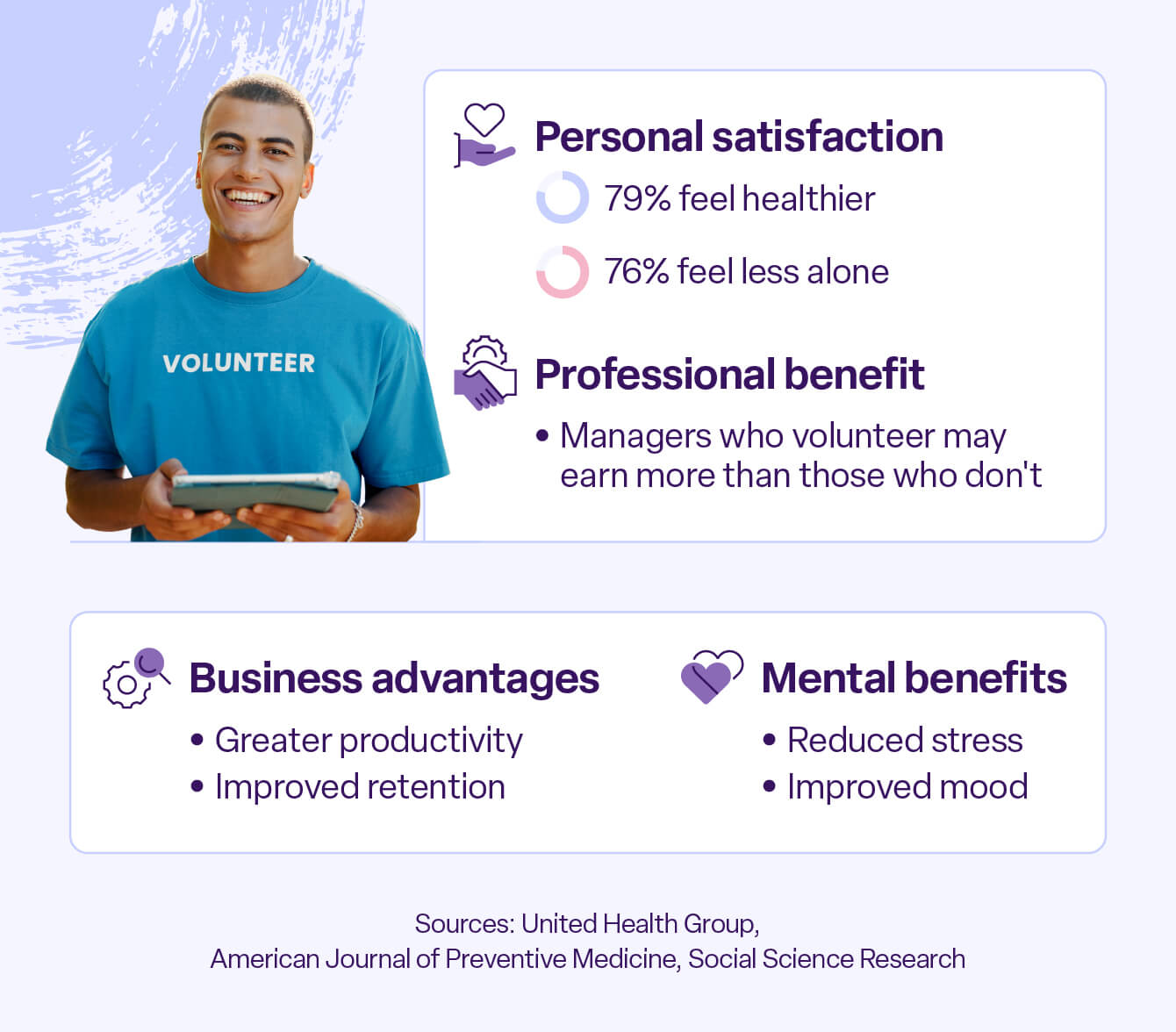
Trends in volunteering
Attitudes and habits toward volunteering in America have changed over time, as have the methods used.
These facts about community service show some interesting trends that suggest the future of volunteering may look very different than what we’ve seen so far.
- 54% of people across the globe indicate they want to volunteer more than they did before the pandemic. (Points of Light)
- Virtual volunteering is becoming increasingly popular, with 18% of formal volunteers now serving completely or partially online. (US Census Bureau)
- New volunteers want more flexibility in the commitments they make rather than having routine time commitments. (Johnson Center)
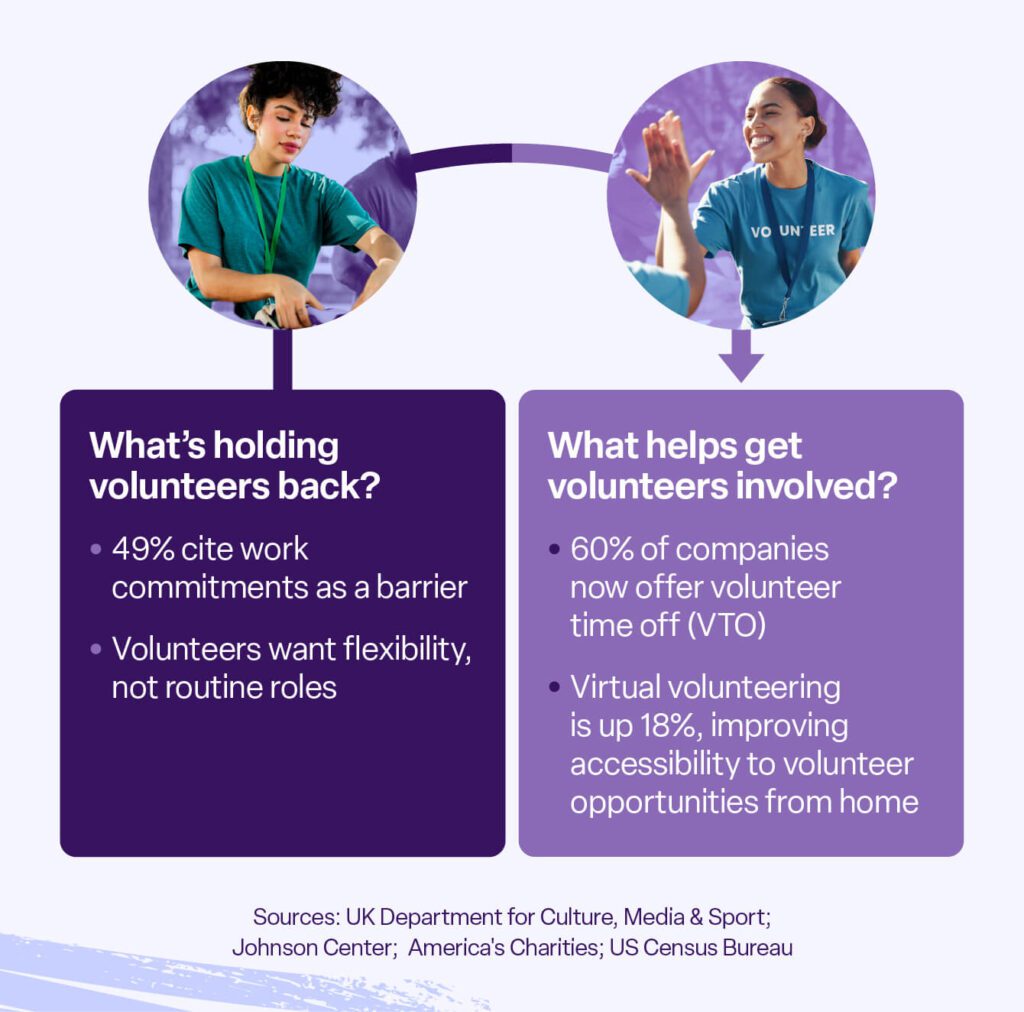
Workplace volunteering statistics
When companies implement programs to encourage volunteering, it helps both employees and the business. Volunteerism in the workplace is a great employee engagement strategy that encourages purpose-driven participation.
Whether they’re volunteering as a team or are given time off to volunteer individually, employees who participate are generally more satisfied and fulfilled both in and out of the workplace. These statistics help demonstrate just how important volunteering has become within U.S. workplaces.
- Two-thirds of US and UK survey respondents want companies to address social challenges. (Points of Light)
- The average corporate volunteer participation rate is 33%. (Double the Donation)
- Of surveyed corporate volunteers, 70% feel that volunteering boosted employee morale. (VolunteerHub)
- 60% of companies offer paid volunteer time off, demonstrating that companies are taking steps to encourage greater participation. (America’s Charities)
- Nearly half (49%) of adults in England cited work commitments as a major barrier to their volunteer efforts. (UK Department for Culture, Media & Sport)
Facts about employee engagement for volunteers
Workplace volunteering can not only lead to more engaged employees, but it can also improve employee retention. In fact, one of the benefits of looking at volunteering statistics is that they reveal how companies that facilitate volunteer efforts can build much stronger workforces.
- Companies that use social feeds to engage their employees in impact work see an approximate 50% increase in volunteer hours. (Bonterra 2025 Impact Report)
- Employees who work at corporations with volunteer programs are five times more engaged than their counterparts at businesses without equivalent programs. (Galaxy Digital)
Recruitment and community engagement statistics
Volunteering doesn’t just help companies recruit top talent. When companies actively promote volunteering, the business is viewed more favorably by potential hires. That’s because this communicates a commitment to supporting local communities and investing in employees’ skills.
Here are some additional statistics showcasing the benefits of volunteering in the workplace:
- Around 70% of employees prefer working for companies that care about their societal impact and support workplace giving and volunteering programs. (America’s Charities)
- Similarly, 70% of employers believe their employees expect them to be socially responsible. (America’s Charities)
- Nearly two-thirds of Millennials are more willing to volunteer if their coworkers do so, and volunteering together can strengthen coworker relationships, promoting loyalty and job satisfaction. (The Millennial Impact Report)
- 77% of consumers prefer buying from companies with CSR initiatives. (Double the Donation)
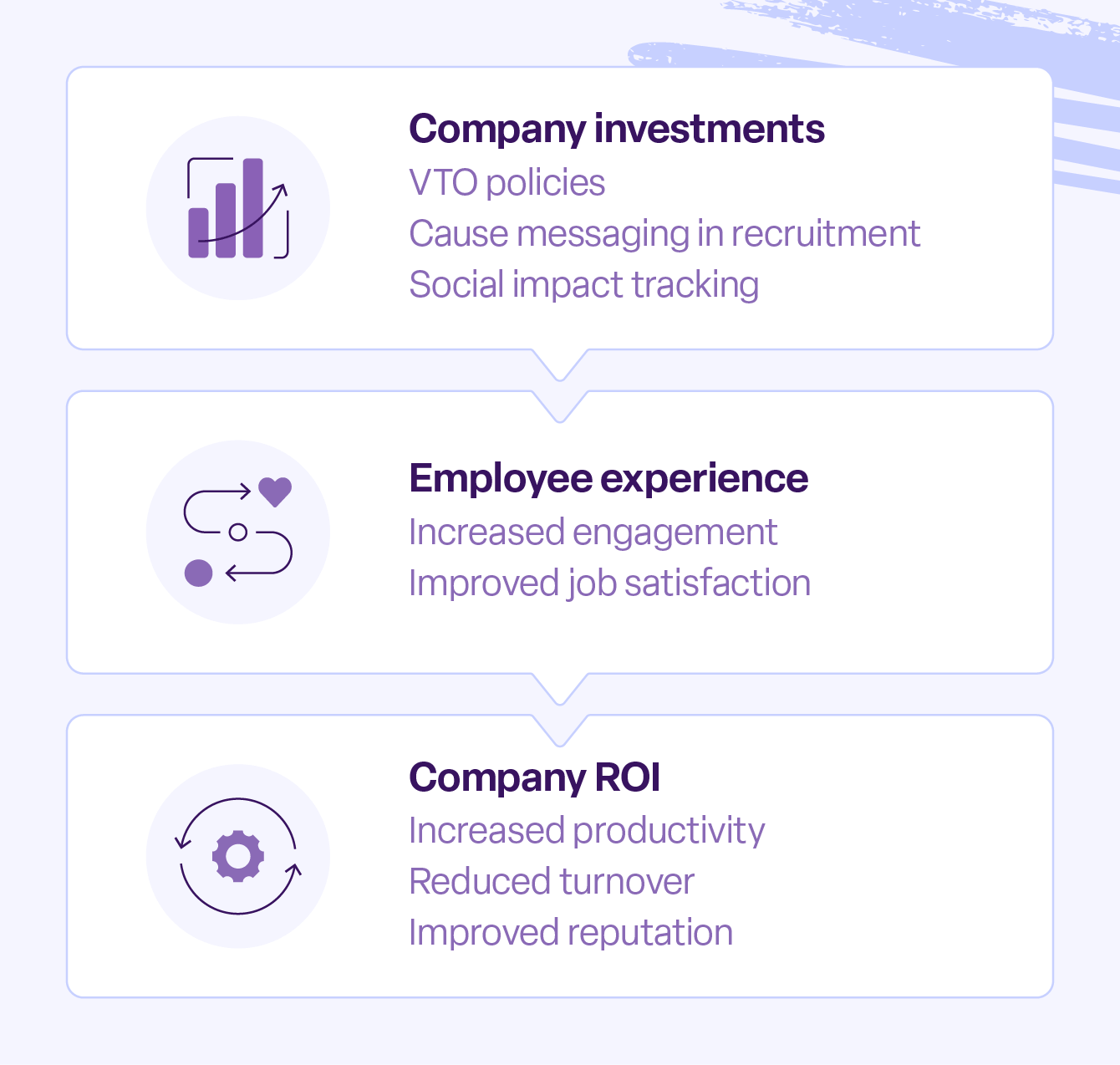
Workplace productivity and volunteering statistics
While there are many fun facts about volunteering to consider, there are also important facts employers need to know to help them decide if they want to implement a workplace volunteering program at their organization.
The data is pretty clear that doing so can have substantial benefits.
- A survey of Fortune 1000 companies found that group volunteering helps employees bond and leads to more productive workplace relationships. (Society for Human Resource Management)
- Volunteering together with fellow employees creates stronger bonds within the organization, fostering teamwork and people skills for 92% of volunteers and building stronger relationships for 77%. (United Health Group)
- In certain types of jobs, including managerial positions, volunteering may contribute to higher pay. (Social Science Research)
- About one-third of surveyed employees want their companies to offer volunteer days to improve their community and demonstrate a commitment to social responsibility. (WTW)
- After 12 months of volunteering, 93% of employees feel less stressed, leading to less burnout, fewer instances of absenteeism, and greater productivity. (Double the Donation)
- Nearly 4 in 5 (79%) volunteers report that volunteering makes them feel better, leading to a healthier, happier workforce. (United Health Group)
- Those who live their purpose at work are more productive than those who don’t. What’s more, they’re more engaged, loyal, and willing to recommend the company to others. (McKinsey)
How nonprofits leverage corporate volunteer programs
To maximize the impact of your company’s volunteer program, you should understand how to effectively collaborate with nonprofits. Nonprofits strategically partner with businesses to harness the skills, resources, and enthusiasm their employees bring to the table.
By understanding their approaches, your company can better collaborate with them to create impactful, rewarding, and sustainable volunteer programs.
Identify corporate partners
Nonprofits seek companies whose values, purposes, niches, and specific types of CSR goals align with their own. For instance, an animal shelter might reach out to local pet stores for support. This ensures a shared vision and enhances the potential for long-term, impactful collaborations.
Nonprofits sometimes also look at the companies where their volunteers and donors work. They use this to indicate an alignment between values. Plus, there may be an opportunity to leverage an existing connection to facilitate an introduction to company leaders.
Publish volunteer opportunities
To recruit volunteers, nonprofits will often publish upcoming volunteer opportunities online. Volunteer management software acts as a hub for volunteer opportunities, helping organizations tap into large networks of passionate supporters.
Nonprofits can publish upcoming roles, events, and petitions, complete with all relevant participation details. Then, anyone can scroll through hundreds of nearby opportunities and find one that fits their needs.
When designing opportunities to attract corporate volunteers, consider common corporate interests and the skills employees can offer. This can range from hands-on activities to pro bono services, ensuring that the nonprofit, company, and employee volunteers benefit from the experience.
Use a corporate volunteer database
Nonprofits leverage corporate giving platforms or databases to find relevant opportunities. Volunteer coordinators primarily use them to search for their volunteers’ employers. Many organizations also put the power in supporters’ hands by embedding an employer search tool into their nonprofit’s website, such as on their volunteer information page.
Whenever the nonprofit or an individual searches for a company, the solution displays relevant details about that company’s volunteer program. It may cover their volunteer grants offering, including employee eligibility requirements, nonprofit eligibility requirements, and grant amounts.
Some solutions will even list volunteer time off (VTO) opportunities for employees. The nonprofit can then reach out to anyone who’s eligible to encourage them to request a volunteer grant from their employer or use their VTO to work with the organization.
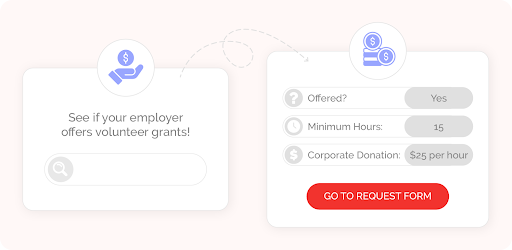
Overall, a volunteer database maximizes corporate volunteerism participation by empowering organizations to proactively identify high-value programs and market those programs to individuals.
Track and report impact
Nonprofits use specialized solutions like Bonterra Mobilize to measure the outcomes of corporate volunteer programs, track volunteer hours, and provide detailed reports to corporate partners. This transparency helps companies see the tangible benefits of their contributions and can be used to motivate ongoing support.
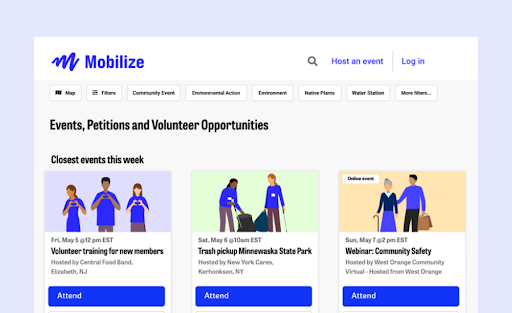
How to start an employee volunteer program
Employee volunteer programs benefit your employees, community, and business. To start experiencing these advantages, meet with your employees to learn what causes matter to them and incorporate them into your CSR efforts.
When launching your CSR program, consider offering opportunities such as:
- Volunteer grants: Businesses that offer volunteer grants promise to donate to nonprofits where employees volunteer. The goal is to financially support the causes employees care about most. Team grants take this a step further by providing larger donations when groups of employees volunteer together.
- Volunteer time off: VTO policies give employees a certain number of paid hours or days to volunteer. This benefit not only supports community engagement but also helps attract and retain employees who value work-life balance and social impact.
- Team volunteer days: Organize group volunteer activities to encourage teamwork among employees while contributing to meaningful community projects. These events strengthen internal relationships and boost morale, creating a sense of shared purpose and pride within the company.
From there, spread the word about your volunteer program in company-wide communications.
Be sure to get your company added to popular corporate giving databases to make it easy for nonprofits and employees to find your program’s guidelines, too.
After some time, check in with participants to request feedback about how you can improve your program and increase employee CSR participation in it.
Launch a successful volunteer program with Bonterra
If you’re inspired by these facts about volunteering and your company is ready to launch an employee volunteer program, Bonterra can help.
Make the most of your CSR initiatives with Bonterra CyberGrants, built to streamline everything from employee engagement to grant management. Whether you primarily want to track volunteer hours or you’re looking for an employee giving platform, Bonterra CyberGrants is designed to make your CSR program run smoothly.
Is your company ready to give back, improve employee relations, and boost your brand identity? Find out how Bonterra can help make volunteering in the workplace a key part of your company culture.
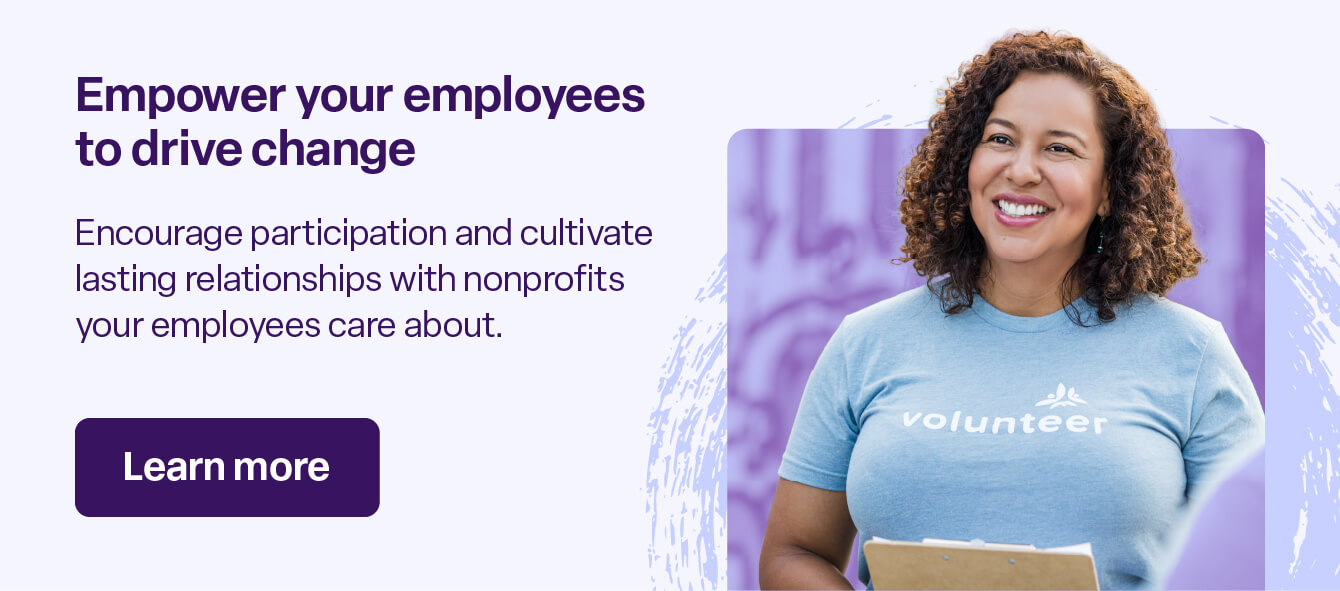
FAQ
How many people volunteer?
An estimated 75.7 million people gave their time to an organization as volunteers, based on data collected by AmeriCorps in 2024.
Why do Americans volunteer?
People volunteer to make the world a better place and improve their own lives. Volunteers give back to their communities while improving their own health, learning important job skills, and making stronger social connections.
How does volunteering help the community?
Volunteering supports vulnerable populations and causes that benefit the public good. The estimated economic value of volunteer time in the US is $33.49 per hour, and a full third of the nonprofit workforce is made up of volunteers. These volunteers offer vital services.
What are five benefits of volunteering?
Five benefits of volunteering include:
- Improving your community
- Improving your health
- Making better social connections
- Learning job skills
- Becoming more engaged at work through corporate volunteer efforts
Work with Bonterra



